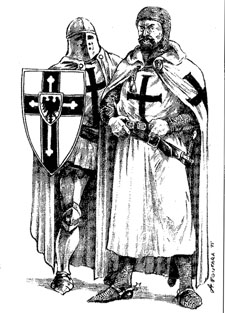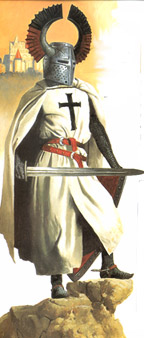
The Teutonic Knights
Written and researched by Margaret Odrowaz-Sypniewski

A Teutonic hospital was established in Jerusalem in the early 12th century, under the jurisdiction of the Grand Master of the Order of St. John (the "Hospitallers"), but it was expelled with other crusaders when Saladin took the city in 1187. The Teutonic Order was officially called "The German Order of the Hospital of the Virgin Mary in Jerusalem" or "The Knights of the Cross" in Poland. They arrived in Pomerania in 1230. The Teutonic Knights were founded in 1190, in Acre, during the Third Crusade. The knights of this order were known as Krzyzacy from Krzyz meaning cross. They wore white garments with black crosses as illustrated in An Illustrated History of Poland edited by Anna Sojka (Podsiedlik-Raniowski & Co. Ltd, Poznan, Poland; 1998.) They were recognized in 1196 by Pope Celestine III. It was decided that they should follow the rules of the Knights Templars at a meeting in 1197. While caring for the poor and sick they would follow the rules of St John's Hospital in Jerusalem. The Pope Innocent II gave them formal recognition in 1199. By 1205, he (Pope Innocent II) gave them the right to wear a white habit with a black cross.

Teutonic Knight's Seal
Teutonic Knights were founded by the burghers of Lübeck and Bremen, with Duke Friedrich of Swabia and King Heinrich, Frederick's brother. Duke Leopold of Austria, Duke Conrad of Mazovia, and Duke Sambor of Pomerellia were also involved.
Louis von Erlichshausen - Grand Master 1450-67. His efforts to suppress the Prussian estates representimg burghers, vassals, and gentry led to the Thirteen Years' War. The Peace of Thorn, 1466, ended the order's last hopes of recovering its lost importance.
Sigfried von Feuchtwangen - Grand Master 1303-11. He moved his residence from Venice to Marienburg, thus establishing the Prussian crusade as the order's primary duty.
Albrecht von Hohenzollern-Ansbach - The last Grand Master in Prussia 1511-25. He introduced Lutheran reforms, secularised the order's domains, married, and became the duke of Prussia 1525-68.
Conrad von Jungingen - Grand Master 1393-1407. His military and diplomatic skill led to the victorious conclusion of the Samogitian Wars. The Treaty of Sallinwerder, 1398, brought peace with Poland and Lithuania and guaranteed his order possession of Samogitia, thus securing the overland route to Livonia.
Ulrich von Jungingen - Grand Master 1408-10. His defeat and death at the battle of Tannenburg marked the end of the order's era of greatness.
Winrich von Kriprode - Grand Master 1352-82. His genial personality and instinctive sense of etiquette won the order firm friends among the highest nobility of Germany, France, and England. Under the supervision the Teutonic Order became famous for its chivalry and courtesy.
Michael Kuchmeister - Advocate of Samogitia, Grand Master 1414-22. Fearing that Heinrich von Plauen's policies would lead to another military disaster, he led the high officers in a coup d'estat, after which everything went wrong. The first Peace of Thorn, 1422, was the true beginning of the order's downhill course.
Poppo von Osterna - Prussian master 1237 and 1241-4. Grand Master 1252-7. From a prominent family in the Nuremberg region, it must have come as a surprise that he separated from his wife to join a military order (she entered a nunnery). Poppo guided the order through its most difficult crisis, the war against Sventopelk of Pomerellia and the Prussian pagans.
Heinrich von Plauen - Grand Master 1410-13. His heroic efforts in saving Prussia from armies of Poland and Lithuania almost resulted in restoring the order's power and prestige.
Hermann von Salza - Grand Master 1210-39. Friend and confidant of popes and emperors, he presided over the order's rise to prominance in the Holy Land and sent knights to Transylvania, Prussia, and Livonia.
Anno von Sangerhausen - Livonian master 1254-6, Grand Master 1257-74. He governed through the critical years following the 1269-60 defeats by the Samogitians and the subsequent revolts in Prussia and Livonia.
Conrad von Thuringen - (Thuringia). Although grand master for only a year, 1239-40, he was the first important noble to join the order. Henceforth it became easier to recruit knights and ask for pious donations of money and lands.
The Order was set up to defend the pilgrims in the "Holy Lands." This Order became more aggressive when crusaders were invited to Poland in 1226 by Prince Conrad of Mazovia, grandson of Boleslaw Wrymouth (1125-1173). Conrad of Mazovia gave them their first order's castle. It was located on a hill on the suth bank of the Vistula across from the river in the city of Thorn (Torun) would be established. The knights were to defend Mazovia against raids from the pagan "Old Prussians," and they settled in Clemo County.
The tribes of Old Prussia were devoutly Pagan. They were Balts who descended from Indo-Europeans. In 997, Saint Adalbert, bishop of Prague, was killed in his attempt to Christianize Old Prussia. In 1009, Bruno of Querfurt met with a similar fate. Polish King Boleslaw III (1146-1173) led the crusade against the Prussians. Then the archbishops of Gniezo promoted the cult of St. Wenceslas, hoping to bring the Prussians into the Christian fold.
In 1217, Hermann von Salza, who was the offspring of a Thuringian ministerial family (knights, but not quite noble), made his pilgrimage to the Holy Lands. He was traveling from Cyprus to Damietta, when he was made a prisoner of the Saracens. This event occured after the fall of Pamietta. Hermann was a Hohenstaufen loyalist.
The new order of German Knights never achieved the status of the Knight's Templars or the Knights of Saint Johns. They did not have their wealth either. It was purely a German movement, although a few members joined from other lands.
In 1225, the Teutonic Order were expelled from their feudal lands in Transylvania by the Pagan Kumans. The following year the pagans were defeated, and the German Knights set up their own State in Baltic lands. This area was, ironically, named "Prussia."
RELATED LINKS:
Malbork (Marienburg), Castle of the Teutonic Knights
SOURCES:
Miller, David. Brassy's Book of the Crusades. Washington, D. C.: Brassey's, 2001
Turnbull, Stephen. Crusader's Castles of the Teutonic Knights (1) Oxford: Osprey Publishing, Ltd., 2003.
Urban, William. The Teutonic Knights: A Military History. London: Greenhill Books and Mechanics, PA.: Stackpole Books, 2000.
MAJOR FIGURES IN THE HISTORY OF THE TEUTONIC ORDER: 
Hermann Balk - The first master in Prussia, 1240-9, and Livonian master 1237-9. Probably a former Canon of the Hildesheim church, he may have joined the Teutonic Knights in Acre in 1189. He died in 1239/40.
Chivalric Orders: A Brief History
History opf the Teutonic Knights at the Battle of Grunwald (New)
Polish Cossacks ... The Sword, Armour, and Costumes
Polish Military History Books
BACK TO THE GERMANIA LINKS PAGE
Last updated on January 2, 2009
© 2000 Maggie973@aol.com
